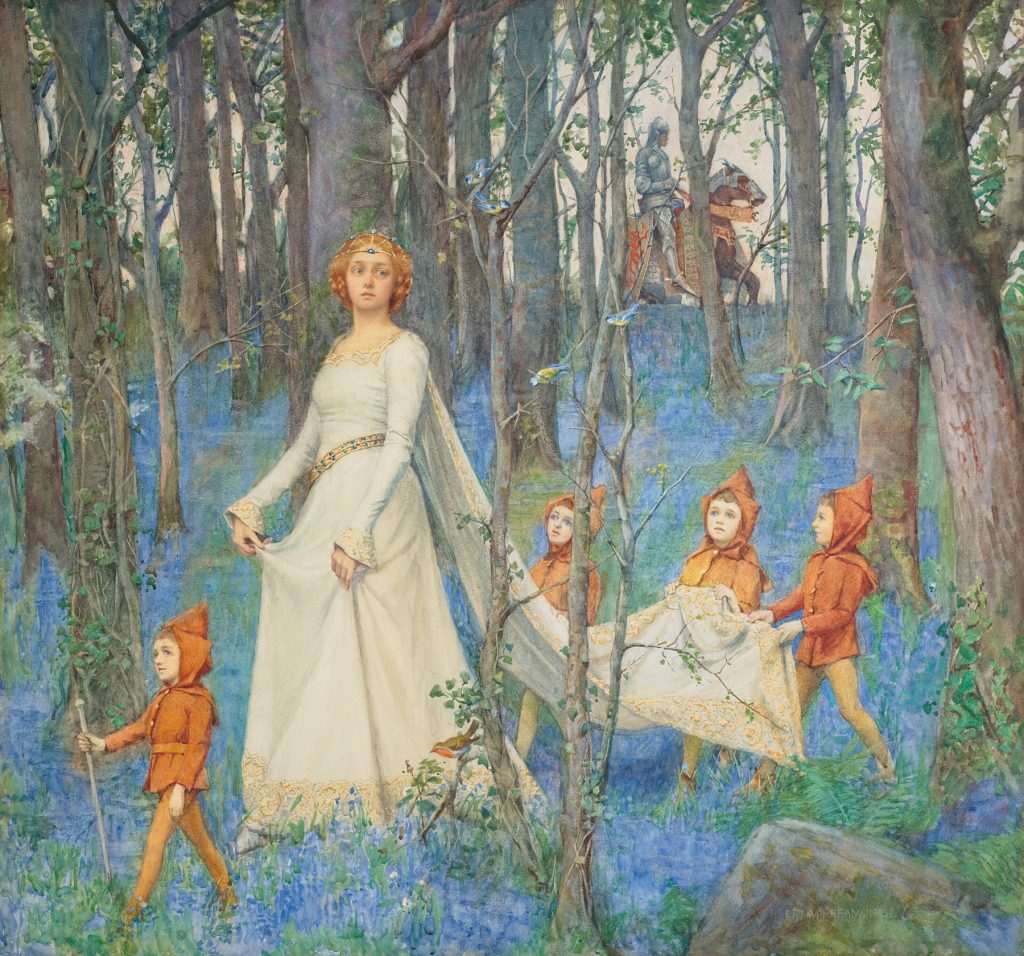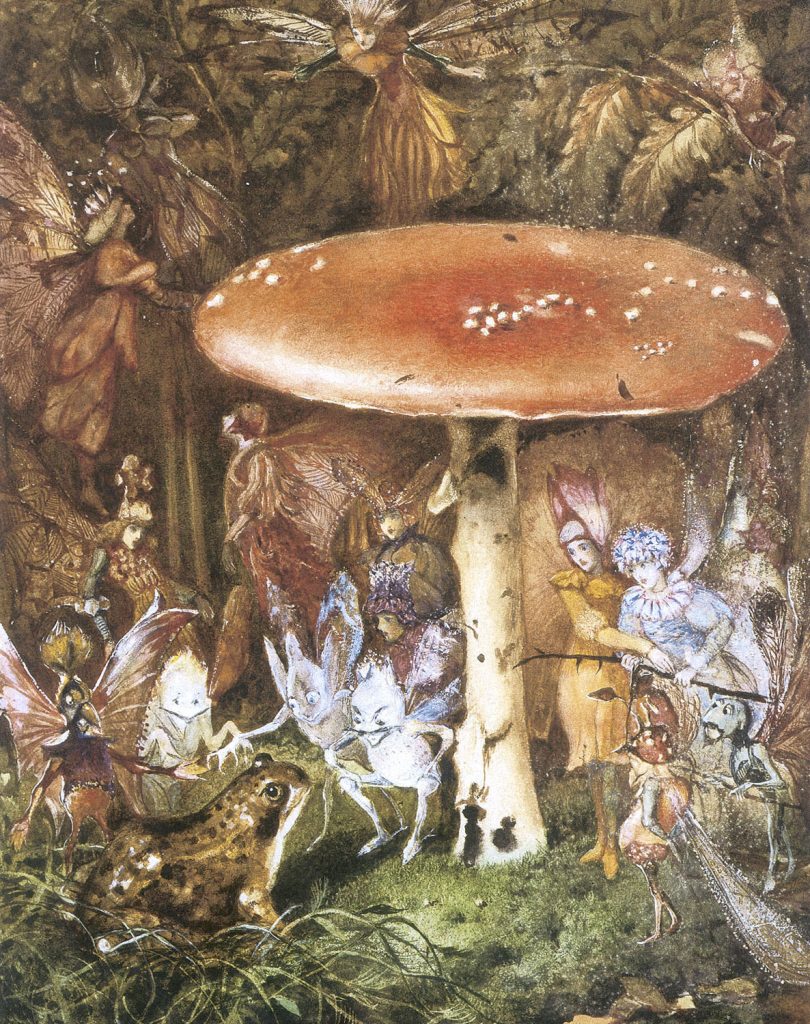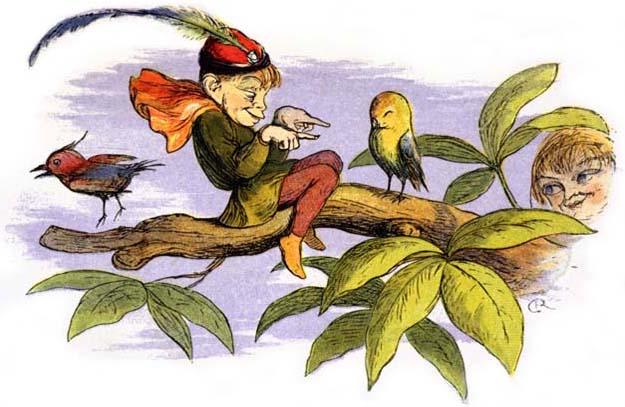Up the airy mountain,
Down the rushy glen,
We daren’t go a-hunting For fear of little men;
Wee folk, good folk,
Trooping all together;
Green jacket, red cap,
And white owl’s feather!
Down along the rocky shore
Some make their home,
They live on crispy pancakes
Of yellow tide-foam;
Some in the reeds
Of the black mountain lake,
With frogs for their watch-dogs
All night awake.
High on the hill-top
The old King sits;
He is now so old and gray
He’s nigh lost his wits.
With a bridge of white mist
Columbkill he crosses,
On his stately journeys
From Slieveleague to Rosses;
Or going up with music
On cold starry nights,
To sup with the Queen
Of the gay Northern Lights.
They stole little Bridget
For seven years long;
When she came down again
Her friends were all gone.
They took her lightly back,
Between the night and morrow,
They thought that she was fast asleep,
But she was dead with sorrow.
They have kept her ever since
Deep within the lake,
On a bed of flag-leaves,
Watching till she wake.
By the craggy hill-side,
Through the mosses bare,
They have planted thorn-trees
For pleasure here and there.
Is any man so daring
As dig them up in spite,
He shall find their sharpest thorns
In his bed at night.
Up the airy mountain,
Down the rushy glen,
We daren’t go a-hunting
For fear of little men;
Wee folk, good folk,
Trooping all together;
Green jacket, red cap,
And white owl’s feather!
(Yeats, 2010, p. 5)
BackGround Information
This is a poem from one of my favorite folktale books, Fairy and Folk Tales of the Irish Peasantry by W.B Yeats. This poem paints a vivid picture of the Fae (also spelled fay). These creatures have a variety of different backstories, but the one I see most common is the angels not good enough for heaven nor bad enough for hell, so they are stuck in the middle. Fae have extremely long life spans and are often described as otherworldly. They reside in a world known as the land of Faerie. The land of Faerie is adjacent to the real world enough so that Fae can travel between the worlds, and humans can accidentally stumble upon it. The land of Feary is often described as a sort of heaven full of comfortable beds, wine, food, and plenty of dancing. Time moves a lot faster in the land of Feary than in the real world. Several years can pass in what feels like hours . There are many folktales where people who visit the land of Feary come back to the real world and immediately turn to dust. You may notice that in this poem, they never describe the Fae by their name. That’s because in Irish folklore, it was thought that calling them by their name would anger the spirits. So people used other terms such as Wee or good folk.
What’s Happening In This Poem?
This is all my personal interpretation of the poem, as there is no agreed-upon interpretation of the text.
The first stanza provides both a description and a warning of the Fae. Avoid areas the Fae are known to roam. The Fae are known to play pranks and become violent when angered. These creatures are often described as wearing red caps (imagine pointy lawn knomb hats) and green cape coats.
The second stanza gives a more whimsical feel to the story. The Fae are known to be intertwined with nature. They are also known to tame smaller creatures, like using frogs as watchdogs or to be ridden on like horses.
The third stanza really had me stumped. I believe this could be describing 2 things. My first thought is that the king has died, and crossing Columbkill is a euphemism for death. On the other hand, it could also be a way to harp on the Fae’s natural mystical abilities.
Stanza 4 describes the phenomenon of Fae stealing people away to the land of Faerie. Little Bridget is a female child who was taken to the land of Faerie for 7 years to either act as a servant or friend. The number 7 throughout history has been thought to be a mystical and lucky number and appears quite often in folklore. Due to time passing faster in the land of the Fae, all of Bridget’s friends and family were long dead by the time she returned home. This is meant to serve as a warning to protect your children, for they can be taken by the Fae. Bridget died, and the fay mistook her for sleeping. While the Fae are known to be cruel to those who anger them, they are also known to be extremely generous to those who treat them well. They cherished Bridget and waited until she woke.
Stanza 5 shows the Fae’s mischievous and vengeful side. They lay thorn bushes around just for the fun of it. However, if someone dared to remove these thorns, knowing they belonged to the Fae. The assailant would find the thorns in their bed at night.
The final stanza repeats the importance of avoiding the Fae. Stay away from the wee folk with red hats, green coats, and white owl feathers.



Doyle, R. (1869). Poor Little Birdie Teased [Painting]. Wikimedia Commons. https://commons.wikimedia.org/w/index.php?title=File:Poor_little_birdie_teased_by_Richard_Doyle.jpg&oldid=1027200020.
Fitzgerald, J. (1860-1865). The Intruder. Painting. Wikimedia Commons. https://commons.wikimedia.org/w/index.php?title=File:The_Intruder_-_John_Anster_Fitzgerald.jpg&oldid=1007397946.
Meynell, H. 1903. The Fairy Woods [Painting]. Artvee. https://artvee.com/dl/the-fairy-woods#00
Yeats, W. B. (2010, October 28). Fairy and folk tales of the Irish peasantry. The Project Gutenberg eBook of Fairy and Folk Tales of the Irish Peasantry, Edited and Selected by W. B. Yeats. https://www.gutenberg.org/cache/epub/33887/pg33887-images.html
